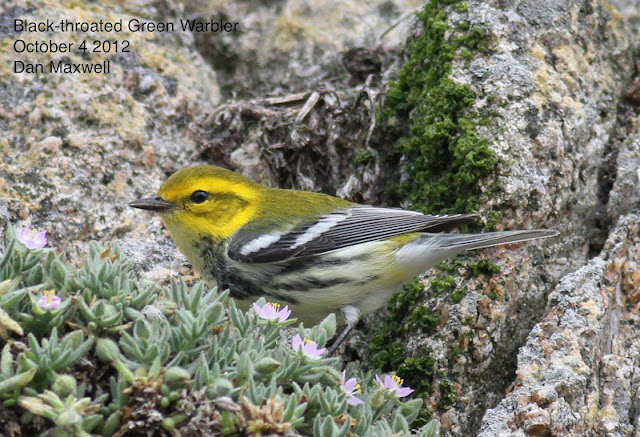DAY 6 - The winds were perfectly southeast and light, but the visibility was too far, so the great landbird wave must have flown back to the mainland. Still we managed to find a few new points. A far from home House Wren was a nice addition to our list. Although we normally see a few of these earlier during August and September, this was our first for the year.
One wave that did materialize was a Burrowing Owl wave. While conducting our morning surveys, owls were flushing from everywhere. It took quite an effort to avoid flushing them and to keep track of the ones we did flush. By the end of the day, our Burrowing Owl intern, Maggie Spilatro, had tallied a very impressive island high count of 17. Furthermore, the previous island high count of 11 was aided by telemetry, which obviously makes finding the owls much easier. Here's one of the owls roosting in its preferred Farallon habitat - a rocky crevice.
Even though we saw Rock Wren on the first day of our Farallonathon, we were pretty excited to finally capture one. Considering that most of this island we live on is rock, there is no habitat to concentrate them near our nets like the other birds, so capturing one is a very low probability event. This bird was aged as a juvenile by its incompletely ossified skull and the molt limit that was present in its wing.
In addition to the point for the House Wren, we also found our first Western Sandpiper, Brewer's Sparrow, and White-throated Sparrows. At the end of the day, another point showed up when a Greater White-fronted Goose took brief refuge on the island. This juvenile lacks the white around its bill that gave its species their name.
At around the same time that we found the goose, we also spotted a shark attack in Mirounga Bay to boost our daily total by an extra 5 points. The five new migrant birds and the shark attack brought our 6-day total up to 150.
DAY 7 - With just 3 knots of wind out of the southeast and 10 miles of visibility, we really thought our final Farallonathon day had the potential to be epic. Inexplicably, though, the wave did not materialize. Instead, we just picked up a few new arrivals, albeit a few extra-stellar arrivals. While conducting shark watch in the morning, Dan Maxwell spotted a nice Hermit Warbler bopping around on the rocks at the lighthouse.
He then got a fleeting glimpse of a bird that appeared similar, but even brighter. Over our handheld radios, he announced that he might have seen a Black-throated Green Warbler. After several hours of anguished searching, Maggie Spilatro relocated the bird on Pointy Cliff while searching for roosting Burrowing Owls. This time Dan got excellent photos for undeniable proof of his sighting. This is a species we normally only see once every other year.
In addition to these birds, we found a distant Flesh-footed Shearwater, a Killdeer, and a flyby Cliff Swallow. Thankfully we also saw two shark attacks (each worth 5 points) and a shark breaching out of the water (worth 1 point). With the 5 points for the CBRC-worthy Gray-cheeked Thrush and 5 points for the other new migrant birds, we were sitting at the end of dinner with 171 points - a respectable finish. But there was still one more animal that we had searched for a few nights previous without success. With just 28 minutes remaining before midnight, and the end of Farallonathon, we succeeded in finding a juvenile Arboreal Salamander crawling around on the rocks to bring our total up to 172.
So how did our 21st Farallonathon rank against our previous attempts? Using our current scoring system, 172 points is just 3 points below the average of 175.29. Still we found some pretty exciting birds such as the Arctic Warbler and the Gray-cheeked Thrush, and we got to see six shark attacks! While the Farallonathon is a lot of fun for us, the main reason we do it is to raise money so we can continue our research. If you enjoy reading about the wildlife we study and would like to help us conserve the Farallon ecosystem, please visit the following website and make a donation:
http://prbo.kintera.org/faf/donorReg/donorPledge.asp?ievent=1035387&lis=1&kntae1035387=2D77273889284701A6B653247CA50095&supId=0&team=5260478
Thanks for following this year's Farallon-a-thon and see you next year!









No comments:
Post a Comment